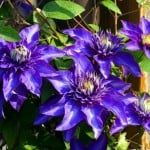Last updated on February 12th, 2022
Our site is reader supported, this means we may earn a small commission from Amazon and other affiliates when you buy through links on our site.
This is a guest post by Guy, he runs a very helpful blog at guyabouthome.com, where he educates people on everything from green living, to decor, to the latest gardening trends. Just like us, he is passionate about helping our declining Bees. Without further ado, take it away Guy!
Bees are more than just insects that produce honey for us. They are responsible for cross-pollination of a whole range of vegetables and flowers. So, they do so much more than produce honey and buzz around the garden.
There is a misconception about bees and how they can sometimes be dangerous. Bees are territorial creatures and would only attack or sting humans on rare occasions, and only when they feel threatened.
These tiny insects play an integral part in the life cycle of most flowers, fruits, and vegetables. Without them inadvertently pollinating each plant they feed on, our fruit and vegetable supply would take a significantly negative hit.
As much as thirty percent of the world’s crops and as much as ninety percent of the worlds wildflowers need an insect such as a bee to thrive. With this in mind, there has been an alarming forty-five percent loss of honeybees in the U.K since 2010.
It’s time to help the bees
If this decline continues, the world will experience a significant food crisis the likes of which we have never seen. These are the best things that you can do to help bees survive and hopefully thrive in your local area.
Using pesticides, herbicides, or fungicides
Using these type of chemicals to get rid of pests will not only kill aphids or other pests but may also poison and kill any beneficial insects. When you use chemical poisons such as pesticides, these often remain in the plant through its whole life cycle.
Bees and other pollinators are poisoned and killed for just doing their job of pollinating plants to make flowers bloom and bear fruit.
Pesticides also end up seeping into the soil which cannot be suitable for your plants. If you have a pest problem, try natural solutions like introducing another insect that feeds on the pests into your garden ecosystem. Ladybugs, for example, love to feed on aphids and frogs feed on slugs.
You can even store ladybugs in your fridge for a few weeks where they will lie dormant until you need them. Just be careful to not to put them in the freezer, and you should be able to store them in your fridge without any problems. Ladybugs are an excellent natural solution to pests.
Not planting native and bee friendly plants
Bees travel far and wide to feed on the nectar of flowers. The more flowers you have in your garden, the more chances there are of bees visiting.
However, we can always make the bee’s nectar gathering activities that little bit easier.
Try planting native species of flowers. Local bees will be more accustomed to these flowers, and they may even be better designed to collect nectar from them! Bees will have evolved to be compatible with the flowers in their area, meaning they can fit into each species to efficiently reach the nectar.
If you’re looking to create a low maintenance garden, native plants are a brilliant option. They are already accustomed to your climate, making them more resilient and easier to look after.
You can also try planting flowers that make nectar collection easy. Flowers such as foxgloves (Digitalis) supply a sort of landing pad for bees so they can take a rest.
Grow flowers that are more traditional instead of growing hybrids which have significantly less nectar. Often if you visit your local garden centre or even online they will show a little bees symbol on the label if they attract bees.
Don’t plant lawns, plant prairies!
Plant shrubs or flowers in your garden and this will ensure you have a steady stream of flying visitors. Planting a good variety of nectar-rich flowers will help the bees in your local area survive and hopefully even thrive.
One lawn per home is enough, although sometimes that is even too much. Lawns are a desert for insects; nothing grows on a lawn except grass. If ever a flower or weed inadvertently grows it is either pulled or mowed along with the rest of the grass once it reaches a certain length.
Consider planting trees that are a favourite of bees and other pollinators. Magnolias or Native Oak trees are among the most liked trees of our nectar feeding friends.
These type of trees not only provide sustenance and shelter for the insects but provide shade and beautiful flowers for us as well.
Make it a point to make sure you take care of your trees correctly. If you make a mistake and ignore certain symptoms of a sick tree like the sudden death of multiple branches, scabs on fruits or the early loss of leaves then take immediate action in an effort to save the tree.
Another great option is to plant vegetables in your garden. Many types of vegetable rely on pollinators such as bees to fertilise them, allowing fruit to grow. One such example is the tomato. Start growing tomatoes at home, and you’ll soon realise just how important bees are.
Fake grass instead of lawn
Lawns may be deserts to insects, however, some people can let their lawns and the weeds that come with them grow. This also allows the weeds to flower, giving pollinators another place to feed.
However, replacing your lawn with fake grass is a sure fire way to completely remove this possibility for the bees. Lots of people see the benefits of fake grass, but for insects, it is a plastic wasteland.
If your home already has fake grass installed, do your best to give pollinators other options in your garden. Container gardens are a brilliant option as weeding isn’t a challenge, and your plants will be portable. This makes changing up flowers and shrubs easy.
Window box planters are also a brilliant way to add colour to your garden and provide a nectar source for bees.
Weeding your garden
Weeds are an excellent food source for insects. If you need to weed your garden, leave some to grow and feed the insects that visit your garden. You can do this by sectioning off a dedicated area for weeds to grow, while the rest of your garden stays ‘neat and tidy’.
Did you know that some weeds can be eaten? Dandelions can be added to your salads, and are known to be a potent diuretic. They can even cleanse your liver!
Ignoring local honey
Purchasing local honey goes a long way to support your local beekeepers. Pure honey has a multitude of health benefits which everyone can enjoy. It is a known antioxidant powerhouse and can also accelerate the healing of various wounds.
By supporting your local beekeepers, you’re also supporting local farming and crops. Bee populations are regularly hired out to farms to help fertilise their crops, allowing a harvest. The result is lots of fresh food available at your local farmers market, and some amazing local honey to try.
Forgetting about water
Installing a little water basin for the bees to drink, perhaps in the form of a small wildlife pond would help them tremendously. If a pond is out of the question then a bird bath would be better. Not only will you help the bees but also the various species of birds in your area.
This way you can have a wide variety of wild birds and insects dropping by for a nice escape from the blazing heat. Add some pebbles or rocks which will work as a perch for the bees when drinking so that they don’t drown.
Throwing away dead stalks
When you notice old hollow stems in your garden, don’t throw them away. Particularly during winter time. Some species of bees and other insects hibernate during winter and use old hollow plant stalks as shelter from the winter elements.
They stay inside those old stalks until spring rolls around where they will then wake up together with the season. Make sure to try your best not to burn them, just set the stalks aside in a quiet corner of your garden, maybe at the back of the shed or some bushes.
Destroying bee nest sites
If you come across a bee nest in your garden; or anywhere in your local area, try your best not to destroy of disturbing the nest. Instead, it would be best just to steer clear of it if possible.
If you want to create a beehive then you can use an old birdhouse. When DIYing somewhere for bees to live, use untreated wood and not use plastics or metal since those are prone to condensation. In compact spaces, condensation can put the bees in the hive at risk.
Or if you want to go down a more serious route, buy a beekeeper kit to help house bees and even produce your own honey.
If a beehive sets up residence in your garden, but you’d rather they didn’t, you can call local experts to arrange for the hive to be rehomed. This way, the bees don’t lose their home.
Not staying educated
Knowledge is power! Make an effort to educate yourself and your loved ones about bees. Explain to them that bees are not dangerous and only attack when they feel threatened.
Bees can be easily mistaken for wasps, so educate yourself and your family about your local bee species so you can tell them apart.
Do your best to share your knowledge about bees to friends, family and the people in your neighbourhood.
Conclusion:
Bees are on the verge of extinction, so let’s all do our part in making our gardens and local neighbourhood more welcoming for them. All the insecticides and pesticides we have been using has made our gardens hostile to our little pollinator friends.
We need bees more than you can know. They are a source of free labour for us when they pollinate our plants and flowers.
You probably wouldn’t want to pollinate plants, flowers, and crops yourself, especially to the scale bees have done for the longest time. Let’s help them continue their work.
Main Photo by Stefan Steinbauer on Unsplash


